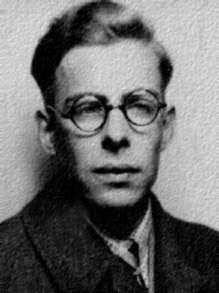Hans Coppi
Hans Coppi (25 January 1916 – 22 December 1942) was a German resistance fighter who was a member of the anti-fascist resistance group that was later called the Red Orchestra by the Gestapo. [1]
Hans Coppi | |
|---|---|
 Hans Coppi, circa 1947 | |
| Born | 25 January 1916 Berlin |
| Died | December 22, 1942 (aged 26) |
| Cause of death | Hanging |
| Nationality | German |
| Occupation | Machinist |
Life before World War II
Coppi was born in Wedding, Berlin to a working class family.[2]
His parents were Robert and Frieda, who were members of the Communist Party of Germany. From 1929 to 1932, he attended the Schulfarm Scharfenberg, a progressive "school-farm" in Berlin's Tegel district. During this time became a member of the "Red Pathfinders" and the Communist Youth Association of Germany (KJVD).
In 1932, Coppi was expelled from the Schulfarm after supporting some students who had watched Georg Wilhelm Pabst's banned Franco-German solidarity film Kameradschaft. He was transferred to the Berliner Lessing-Gymnasium. In the meantime, Adolf Hitler's Nazi Party had assumed power in Germany.
Following the Reichstag fire in March 1933, for which the Nazis blamed communists, Coppi took his political views and activity underground. Within a year, however, he had been arrested by the Gestapo and sent to Oranienburg concentration camp for two months without trial. He was then imprisoned for one year for handing out illegal leaflets.
After his release, Coppi found work as a lathe operator and made contact with old friends from the Schulfarm aiding victims of Nazi persecution. He continued to co-write leaflets warning of the consequences of Nazi warmongering.
World War II
At the outbreak of World War II in autumn 1939, Coppi was deemed unfit and unworthy to be a soldier. Instead, he joined Wilhelm Schürmann-Horster's resistance group and established contacts with the communist "Red Orchestra" resistance circle. He agreed to pass information about these groups' activities to the Soviet Union by radio.
In 1941, Coppi married Hilde Rake and the couple continued to aid victims of persecution and illegally relay information to and from Soviet radio. The following year, Coppi was given care of a Soviet agent who had been parachuted into Germany; and, as the tide of the war turned against Nazi Germany, Coppi received papers calling him up as "suitable" for service in the Wehrmacht.
Downfall
On September 12, 1942, Coppi and his pregnant wife were arrested in Schrimm (now Śrem, Poland). His parents, brother and mother-in-law were also arrested around this time. He was convicted by the Reichskriegsgericht and sentenced to death on December 19. Three days later, he was hanged along with fellow resistance members Arvid Harnack and Harro Schulze-Boysen at Plötzensee Prison in Berlin.
Hilde gave birth to their son, Hans, on November 27, while detained at the Barnimstrasse Women's Prison in Berlin. She was executed less than a year later, on August 5, 1943.
Bibliography
- Hans and Hilde Coppi are remembered in Peter Weiss' novel Die Ästhetik des Widerstands ("The Aesthetics of the Resistance", written 1975-1981).
- In 1999, Geertje Andresen and Hans and Hilde Coppi's orphaned son, Hans Coppi Jr., published a collection of Harro Schulze-Boysen's letters, Dieser Tod passt zu mir ("This Death Becomes Me").
References
- Coppi Jnr, Hans. "Hans Coppi". Stolpersteine (in German). Berlin: Koordinierungsstelle Stolpersteine. Retrieved 4 January 2019.
- "Hans Coppi". Gedenkstätte Deutscher Widerstand. German Resistance Memorial Center. Retrieved 20 October 2019.
External links
- (in German) Timeline of Coppi's life by the Deutsches Historisches Museum.
- Plötzensee Prison
See also
- Zentralfriedhof Friedrichsfelde The Socialist Memorial